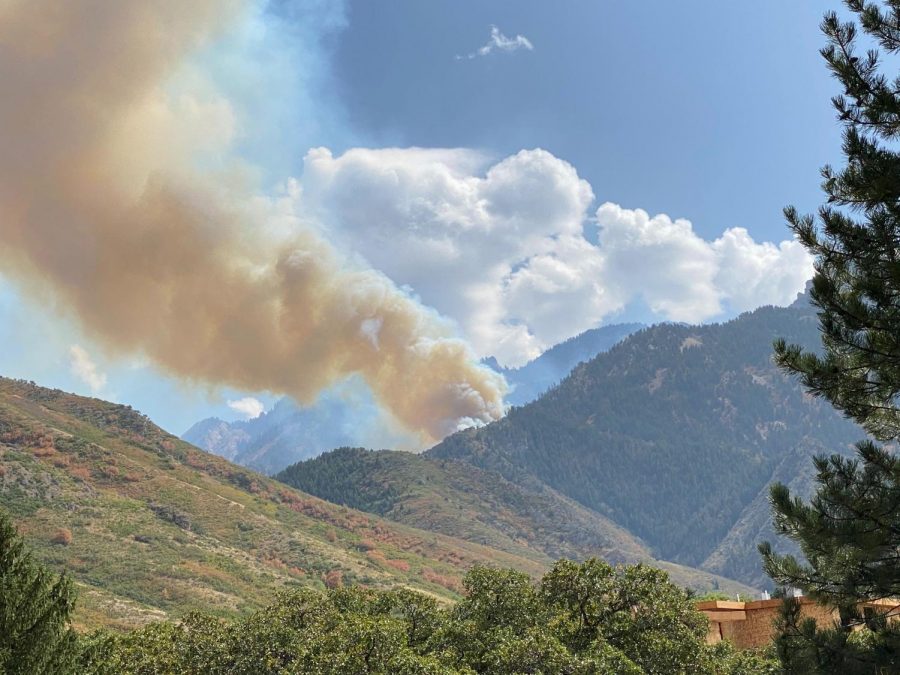Shadley: How To Address Utah’s Wildfires, Air Quality, and Climate Change All at Once
January 30, 2021
Last summer, outdoor activities were the only refuge from COVID-19, but the 2020 wildfire season made even that a danger to our health. Whether indoors or out, every breath posed a threat. While our state has rightfully dedicated millions to fighting the pandemic, only one bill in the current session for the Utah State Legislature, H.B. 65, is aimed at directly addressing fires in Utah, and it comes up far short of the action we need to mitigate climate-enhanced wildfires.
After a record-breaking fire season in 2012, Gov. Gary Herbert asked his Commissioner of Agriculture to develop a strategy aimed at reducing the severity and frequency of wildfires. But with record-breaking property damage in 2018 and record-breaking quantity of fires in 2020, I don’t think it’s controversial to say that their strategy failed. What may be controversial is to argue that the reason for its failure is, primarily, climate change. Only 55% of Utahns are concerned about climate change, but three Utah counties — Uintah, San Juan, and Grand — show reported temperatures that are rising at twice the national average. Those alarming numbers set us up for an increased likelihood of abnormally hot and dry conditions, which are prerequisites for worse fire seasons.
As wildfires become more destructive, their economic and health effects do as well. This past year, the state spent about $60 million suppressing wildfires. In addition to additional suppression costs, wildfire smoke contains small particles of burnt plant-matter which can cause inflammation and exacerbate other health problems. Those health complications add to our healthcare costs and decrease the quality of life for countless people. Contrast those costs with the meager additional $435,000 that would be appropriated by H.B. 65 for hiring full-time fire wardens and creating a public risk assessment map. While these proposals are net-positives, the size and scope of the bill is greatly underwhelming. Such an inconsequential bill squanders a unique opportunity for the legislature to address Utah’s air quality — an issue that 90% of Utahns consider a top priority.
But if I’m going to assert that the legislature is doing too little to address the wildfires in our state, then I owe it to them and to you to offer some guidance on specific policy proposals we should adopt. There are three areas of policy that need to be addressed to reduce the severity and frequency of wildfires: climate change, fire management practices and human behavior.
To get a better understanding of wildfires, I spoke with Dr. Derek Mallia, a Research Assistant Professor at the University of Utah’s Department of Atmospheric Sciences. Mallia agrees that climate change is the biggest factor pushing us towards more intense fire seasons. Action on climate change has been slow in Utah, with only 6% of our energy coming from renewable sources in 2018. While more aggressive policies are necessary, it’ll take far more than my allotted 1000 words to explain all of the ways we can reduce emissions.
On the topic of fire management practices, Mallia noted that a “secondary kind of problem [in addition to climate change] is the extra vegetation that we have because we’ve been putting out fires so much,” and “prescribed burns are the one way that we can very quickly address that.” The extra vegetation, exposed to hotter and drier conditions, becomes fuel that leads to more severe wildfires. Mallia and his associates have created a model that could be used to determine when to perform prescribed burns. The full-time fire wardens that would be added via H.B. 65 could utilize the model with input from ecologists and air pollution specialists to limit the dry vegetation for wildfires.
Of the 1539 wildfires in Utah this year, 1202 of them were started by people. While those fires only accounted for about one-third of the acres burned, any comprehensive wildfire prevention program from the legislature would address the human behaviors that lead to wildfires. The majority of human-caused wildfires are a result of campfires left unattended, the burning of debris, automobiles and other equipment use, cigarette butts, and arson. Wildfire education efforts tend to be successful and cost-effective and extra funding would be a simple inclusion to H.B. 65.
Additionally, Utah’s fire restrictions are currently released intermittently and only prevent activities in a given area once that activity is deemed to be too risky because of the conditions. With this system, only the most diligent and fire-conscious outdoor recreationists are apprised of the fire restrictions at any given time and place. Naturally, these aren’t the people most likely to spark wildfires. As our seasons get hotter and drier, sensible restrictions on campfire use, off-roading, target shooting, debris burning and firework use would make the rules clearer and more accessible to all outdoor enthusiasts, leading to a decrease in human-induced wildfires.
While these recommendations represent only a fraction of the possible ways to reduce the severity and frequency of wildfires, they would nonetheless increase the effectiveness of H.B. 65. Utah’s lackluster commitment to addressing climate change and properly funding wildfire prevention is destroying valuable property and unique ecosystems, costing our state millions of dollars and creating unnecessary chronic health conditions. And, while Prof. Mallia noted that wildfires “are not just a Utah problem, but a western U.S. problem,” there is no reason our state should not strive to be a leader in addressing wildfires.
The past year has been evidence enough that “an ounce of prevention is worth a pound of cure.” Yet, on an issue that a vast majority of the state believes needs to be addressed, the legislature’s most wildfire-centered bill, H.B. 65, offers up little more than a gram.








